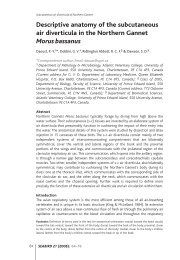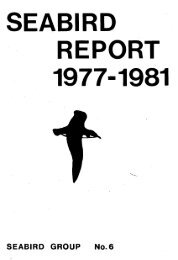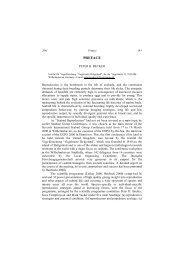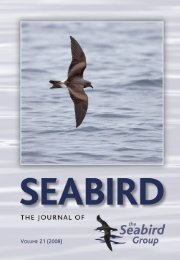Vol 6 No. 2 - The Seabird Group
Vol 6 No. 2 - The Seabird Group
Vol 6 No. 2 - The Seabird Group
Create successful ePaper yourself
Turn your PDF publications into a flip-book with our unique Google optimized e-Paper software.
42 R.T. BARRETT ET AL. Atlantic <strong>Seabird</strong>s 6(2)<br />
died in Shetland in January 1993 (Weir et al. 1996), and suggests different<br />
behaviour patterns between the sexes early in the breeding season. Gabrielsen<br />
(unpublished data, pers. comm.) found that male Black-legged Kittiwakes may<br />
attend the nest for as long as 5-6 days and twice as long than females just before<br />
egg laying. It is possible therefore that the males in Finnmark remained longer<br />
than the females in the colonies (to defend their nest sites after the females had<br />
left) such that they were in poorer condition when they finally left. It is also<br />
possible that females at this time of the season would have built up body<br />
reserves prior to egg laying, thereby giving them a better chance of survival.<br />
Unpublished studies suggest that, in the absence of food, adult<br />
kittiwakes in normal pre-breeding body condition would exhaust all body<br />
reserves within 5-8 days (G.W. Gabrielsen, pers. comm.). Those that waited too<br />
long in the Finnmark colonies would probably have been too weak to forage<br />
efficiently when they finally reached the capelin in Troms, and subsequently<br />
succumbed.<br />
At the time of the wreck there were reports of apparently starving<br />
kittiwakes ignoring dead capelin that were floating on the sea surface in the area<br />
of the wreck. <strong>The</strong>se are fish that die after spawning (Gjøsæter 1998). In<br />
subsequent conversations with fishermen, this paradox was corroborated by<br />
their reports of gulls Larus spp. also avoiding these fish during the capelin<br />
spawning season. Why these fish were not eaten is unknown.<br />
Kittiwakes probably survived the capelin shortage in the 1986/87<br />
winter in that the few that were not dispersed outside the Barents Sea were<br />
either able to move quickly to richer feeding grounds or survived on, for<br />
example, crustaceans that not suitable for auks. <strong>The</strong> following breeding season,<br />
however, was for many species in Finnmark one of complete or very nearly<br />
complete breeding failure, again suggesting insufficient movement of capelin<br />
into coastal waters in 1987 (Vader et al. 1987, Gjøsæter 1998). By 1989,<br />
however, when the capelin stock had recovered only slightly and was still very<br />
low, breeding success was again normal (Barrett & Furness 1990).<br />
By mid-May 2003, all colonies in Finnmark that had been abandoned<br />
were reoccupied, and breeding proceeded, albeit a little late. This coincided<br />
with reports of small amounts of capelin spawning in East Finnmark (H.<br />
Gjøsæter, pers. comm.). On Hornøya, kittiwakes started to lay 2-3 weeks later<br />
than usual, around 1 June (RTB, pers. obs.), although mean clutch size reached<br />
1.4 eggs/nest (SD = 0.83, n=845 nests), which is normal for the colony (mean<br />
for 21 years = 1.4 eggs/nest, RTB. unpublished data). As in 1987, however,<br />
fledging success was very low as a result of chick starvation (RTB, pers. obs, T.<br />
Boulinier, pers. comm.). Although not monitored in detail, the 2003 kittiwake<br />
breeding season on Bjørnøya was rather poor, with fewer pairs than usual laying<br />
eggs, and low breeding success (H. Strøm, pers. comm.). Furthermore, there








